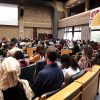Monday, May 13, 2024
News and Views from the Global South
HEALTH: Namibia Makes Strides in Paediatric HIV
Servaas van den Bosch
- While paediatric HIV remains a growing concern throughout Southern Africa, Namibian doctors have managed to put high numbers of babies on the life-saving antiretroviral (ARV) treatment with the help of an early infant diagnosis (EID) programme based on dry blood sampling.
Since the launch of the EID programme in 2006, the number of HIV-infected newborns has dropped from 13 percent to two percent in Namibia, according to the national Ministry of Health.
These figures stand in sharp contrast with data from other African countries where many pregnant women are not diagnosed in time to prevent mother-to-child transmission (PMTCT) of the virus and only a few HIV-positive infants receive ARVs.
A 2009 study by the Centre of Infectious Disease Research in Zambia (CIDRZ) of HIV-positive mother-infant pairs in Cameroon, Ivory Coast, Zambia and South Africa, for instance, revealed that almost half of HIV-positive mothers who received ARVs to prevent the transmission of HIV to their unborn children did not complete the treatment. As a result, their babies were infected with virus.
Swaziland is another Southern African country where paediatric HIV remains a significant problem. "We have one of the ugliest HIV-situations in the world with a prevalence rate of 26.1 percent and one in every two pregnant women infected," explained Doctor Caspian Chouraya, medical officer at the Elizabeth Glaser Paediatric Aids Foundation in Swaziland.
In Namibia, the situation looks much more positive. "7,622 children are receiving ARV treatment," claimed paediatrician Angela Mushavi, who is PMTCT co-ordinator at the United States' Centers for Disease Control and Prevention (CDC), the main donor for Namibia's EID-programme. Namibia has about 20,000 HIV-positive children, according to CDC.
Namibia's progress in paediatric HIV has been particularly impressive, in light of the challenges facing its health care system. Although 80 percent of Namibians live within an hour’s travel of a clinic, according to the 2007 Demographic and Health Survey, many crucial health services are only available at the 34 state hospitals that are scattered across the vast and sparsely populated country.
Major progress
Mushavi credits the use of dry blood sampling for bridging this gap. "Dry blood sampling is used in 98 percent of all HIV tests," she explained. "The caregiver draws some blood from the baby’s fingertip and smears it on special filter paper. The advantage is that it doesn't require scarce medical staff, and the sample can be preserved for several weeks, so it survives the long journey to the laboratory in Windhoek."
Through a computer network, the results are relayed back to local health facilities that then contact the patient. "The turnaround time is about two weeks," said Mushavi.
The downside of EID testing, however, is that infants can only be tested from 18 months onwards, when the baby's test results will be clear of the HIV-positive mother's antibodies. Polymerase chain reaction (PCR) tests, which can be used on newborns from the age of six weeks to identify DNA changes caused by HIV, can still only conducted by the Windhoek-based Namibia Institute of Pathology.
Still, the EID programme, which has been rolled out in all the country’s antenatal clinics, has made major strides in reducing paediatric HIV.
While HIV-positive adults only receive ARVs once their CD4 count drops below 250 – a measurement of the number of T-helper cells, indicating weakness in the immune system – HIV-positive infants are put on ARV treatment immediately after testing positive.
"All HIV positive infants under twelve months receive ART. Thereafter we follow the World Health Organisation criteria, which look at CD4 percentages and clinical stages of sickness," explained Mushavi.
Child mortality
Infants with HIV are much more likely to quickly develop AIDS and succumb to opportunistic infections because their immune system is not yet developed enough to fight the virus. United Nations Children's Fund UNICEF indicates that without treatment, half of infected children do not get to celebrate their first birthday.
The Namibian health department has also made sure that adhering to ARV treatment is easier for infants and their caregivers. According to Okokwu, the department gives out ARVs in dissolvable tablet form instead of as paediatric syrups, which is generally provided through the hospitals. The tablets are easier to dispense and transport back to the rural areas, he says, and do not need to be stored in a fridge, like the syrup. Many people in rural areas do not have electricity to power a fridge.
In addition, the health department provides HIV-positive children with a mineral and vitamin nutrition supplement in six of the country's 13 provinces to boost immune systems and fight malnourishment.
Yet, despite hailing the Namibian EID-programme as "fantastic", Okowu says there is still more that could be done: "Namibia has done well in combining sound policies with technical support from donors. There is also a drive towards decentralisation of healthcare provision, but there are still children falling through the cracks."

 Print
Print



